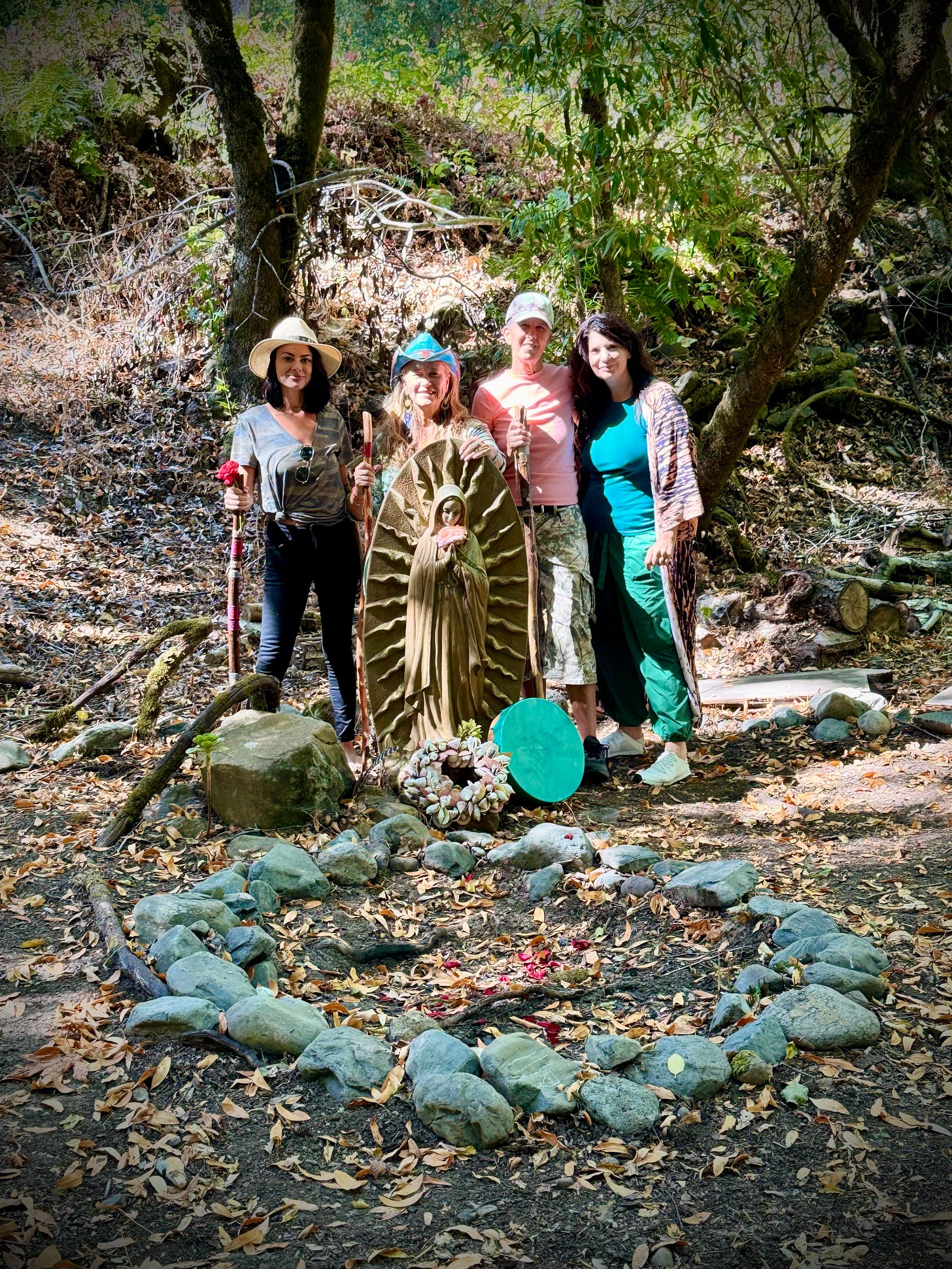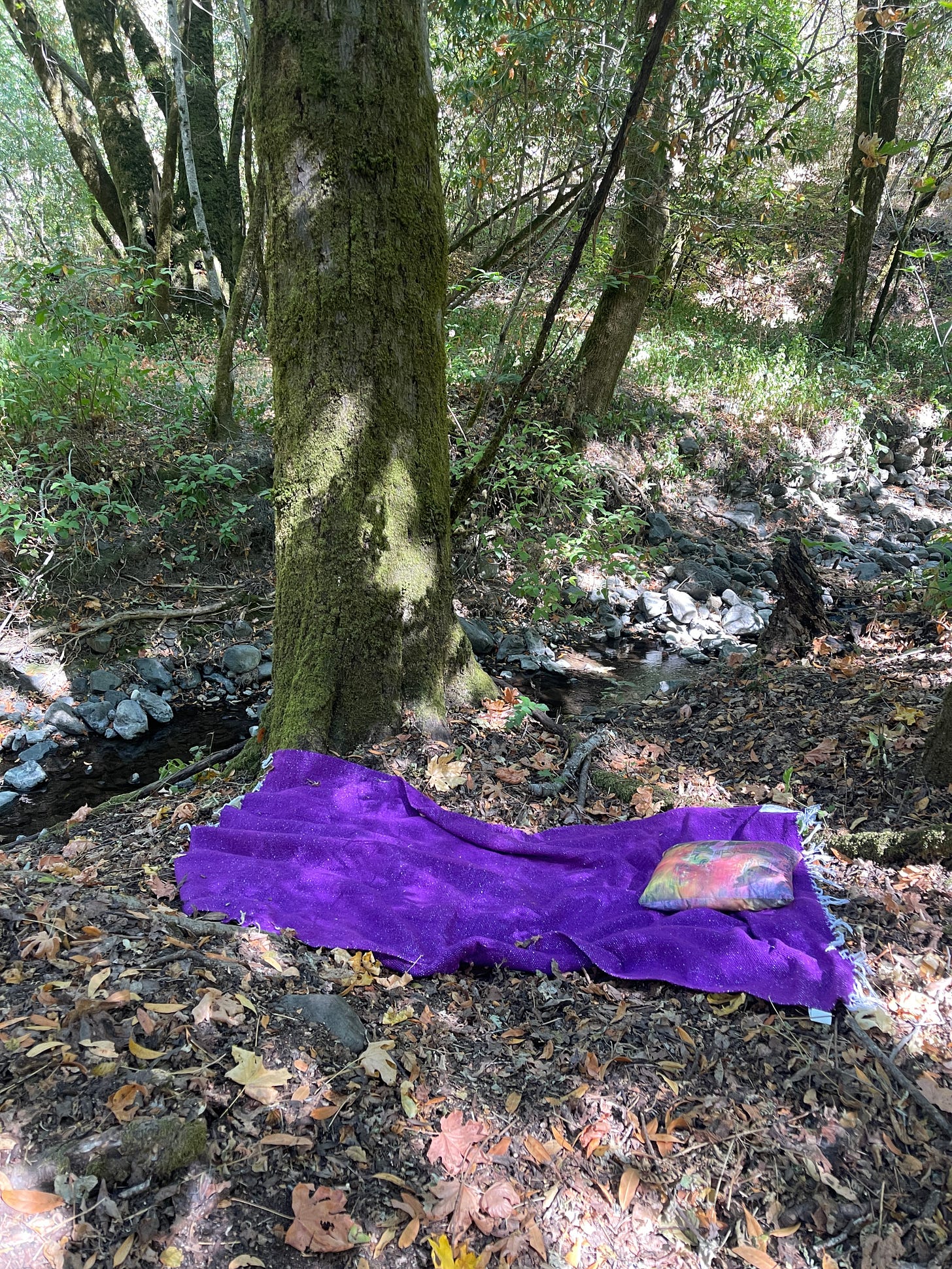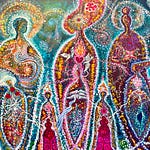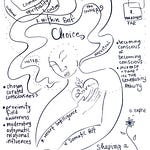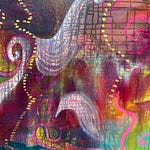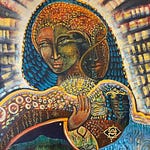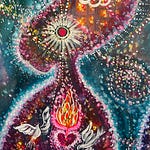Here I am with friends at Wild Water Creek
This is the three year anniversary cycle of becoming a steward of a particular ground and being of water up on Sonoma Mountain in California. Currently I am in Portugal and you may hear the waves in the podcast :)
In this episode
How my painting gave me instruction (Clan Cura Legend)
The challenge with ownership of land - it’s a riddle
The call to protect while still having a “Settler headset”
Healing a childhood wound at the door of memory and reality
The female deities of the mountain where I live - what I feel they said to me
Inquiries about being in right relationship with indigenous people and how necessary yet almost impossible it is to do well. Yet begin good company is a way to begin.
Small feeble, yet honest, attempts at reparation that continue for years on end and get really specific in relationships
Acknowledging I will never get it right, yet that I’m engaged in the journey and the conversation as part of my life and my life force.
Knowing that even as I write this People of Color can find flaw with everything I’m sharing, but I have to share it anyway as a part of how I learn. When they correct me, they teach me. When they honor me with their stories, they teach me. I know, I know, that those who are oppressed get tired of telling the European people how to do it. But somehow we have to find a way to do this together. I just keep leaning in and doing what I can along the way….I want to. Not because I SHOULD but because it is how I feel.
Curate Shiloh Sophia
A Quote about the book from Right Story Wrong Story by Tyson Yunkaporta
”These pages and carvings of stories aren’t talking about the way things were in the good old days, or even the remnant cultural processes that still work well for our Indigenous communities today. These knowledges are present, but they inform the lens for our inquiry into the state of the world. They don’t provide exotic content to be consumed by readers looking for ancient wisdom. Ancient wisdom may provide examples of healthy models of governance, economies and technologies, but these can’t really help at the moment unless there is a through-line to now. These things can only help if examined alongside stories of development, growth, cybernetics, liberalism, modernism, post-modernism, post-truth and the other dominant abstractions that are shaping our reality.”p.s. I called it the wrong name in my podast. I would suggest this book to anyone and everyone
If I’m just quiet all the time because I know I’m not gonna get it right, then that’s just more silence. I’d rather get it wrong and learn more. This is wear I lay to get quiet at Wild Water Creek.
Feel free to subscribe to join us for the September 21 Solstice Ceremony. Tithe toward the eight ceremonies of the year if you feel called to support our work. Otherwise, everything is still available complementary.
Sending love from Portugal. I’m on a five week pilgrimage for rest and research. Portugal is the first stop on the journey.
Grateful,
Curate Shiloh Sophia
Three years ago, I was in the process of a painting. It was for a class called Legend, which we've taught every year since around 2008. I was midway through the painting and I had made this big sleeve, like a really big sleeve on the garment of the archetypal image of the matriarch that was coming forth, literally arising from the layers and layers in my painting. I instantly regretted the sleeve, it was so big. It was as big as her head.
And then of course, I did what I do in our work called Intentional Creativity. And I asked the question, what is this sleeve? When you listen in that space with your brush suspended in midair, information often comes. I heard clearly Clearly, this is your Mother's sleeve. And I saw an image.
I saw the image of a dress that my grandmother and my mother used to move outof welfare and into creating a thriving six-figure business in the mid-70s. This dress had a giant sleeve and wasn't like anything of any of the dresses that were out at the time. My mom's idea for this dress was that a woman could wear it to cook and to work. She could wear it barefoot at the beach. She could dress it up with pearls and high heels. It was called the Forever Dress.
So I began to think, okay, what is it about this sleeve and the Forever Dress that my insight is wanting to reveal to me at this time through this painting process? I asked, all right, what goes in this sleeve? And this is how painting goes, question after question after stroke. Instantly I heard: Sonoma Mountain. As I began to lay the mountain in, I began to have a feeling in my body, a change of chemistry.
Let me give you a little context that Sonoma Mountain, it is the birthplace of creation for the coastal Miwok people in the area of Sonoma and Marin. It's a mountain that I have a very special relationship with because of that, also growing up all my life near it,also looking at it out the window at our MUSEA center in Sonoma. Feeling a sacred relationship with this place of honoring it and to offer land acknowledgements to Sonoma Mountain.
This is part of my duty as a European settler is to discover what is right relationship within the framework of an indigenous culture that has been taken over by my ancestors.
So I had this feeling as I was laying in this mountain, which I was drawing from energy and memory, and instantly I received the instruction:
Go to the mountain now.
(Those of you who were in that class, which was the Clan Cura Legend class, will know that I turned off the camera.)
As I'm driving, I'm asking myself, where is access to the mountain? Like direct access where I can put my feet on the ground. I pass the area known as Grove Street or Diamond A, where I realize every single point of access is owned. Must I go all the way to Glen Ellen to put my bare feet on the rocky red soil of Sonoma Mountain? Must I go to Jack London Park?
As I'm going, I'm trying to figure out how is this going to work? I mean, I could just park my car and get out on the side of a road in a pullout, and that's what I'm planning on.
However as I arrive in Glen Ellen, about to make the turn up to Jack London State Park, I see it, the place where I used to live when I was five years old, when everything changed. It's the place where a different level of fear and violence was introduced into my family framework.
We were living above a store called Shones Market in this gorgeous old building. Now it’s a marketplace with wine bars and lawyers. But then it was a home, covering the whole top floor. This is the place where I lived when I became conscious enough to understand that my family was involved in saving, hiding, and rescuing women. from extreme acts of violence taking place right there in Sonoma. This whole experience would end up leading to the very first ever rape trial case coming to the court system. As a child, being exposed to this information was curious because you take in what you take in, you leave out what you leave out. What I was aware of as I was there in Glen Ellen deciding whether to go left was that I needed to make amends with this house.
I walked up the stairs to the door, remembering hiding under the stairs, not from the bad people, but hiding with my cousin Bridget as we made little fairy teas with miner's lettuce and chamomile across from the laundromat. As I walked up those steps, so many memories, and I touched my palm to the door, which was the same door, and I said to that child self,
Oh, I'm so sorry. You did as good as you could, and so did the mamas. The mamas were helping other mamas.
Oh, there's so many stories that are for another time. But this is about getting to Sonoma Mountain. But of course, on the way to the mountain, there was an assignment, make amends with the house. And so I did. Back in my car, I have an idea. Why don't I call up a real estate agent where there's land for sale that doesn't have a house on it, ask to go and look at it because I'm always looking at land, and then have permission and walk on.
I found a place just a few miles from where I was parked, called, an agent answered, and then off I was. Eventually turning onto Sonoma Mountain Road itself. I pull over where the GPS tells me, I get out of my car.
I walk a few feet to discover a glorious creek that is still filled with water in August. It was hot. As soon as I stepped on that land…
I felt the call. I want to be a custodian, a steward of this place. I don't know anything about it. tell me.
I just stood there with my feet in the creek listening. It was a call in my gut. You know, it's hard for those of us European settler types to not feel that call, it's built in. and that call to own a call to possess, a call to have ground that no one can take you off. This is completely contraindicated to the reality that you cannot own anything and that the idea of owning land is preposterous and is a huge part of the problem. So You, I, have to grapple with that settler mentality.
You have to grapple with that desire to protect and preserve what is yours, which can never really be yours. It's a kind of a headset about getting into stewardship of custodial right relationship with, which can never actually be the case, because you cannot actually own it. (Land owns itself but it doesn’t call it that)
Yet what I discovered is that many people had bid on this land and they wanted it for logging, they wanted it for water, they wanted it for building. The redwood trees. Oh, the redwood trees. The old growth. Not so, so old, but old enough. I felt that feeling in my gut not to own, but to protect and preserve. But that's hard in a settler mind because you almost have to negotiate with your intellect. Yet, what I felt in that moment, which to an indigenous person, doesn't make sense, and to a land-owning class, doesn't make sense.
Wanting to steward this landa and water was somewhere between wanting to be in right relationship with it, knowing that I never could, wanting to protect it and wanting to keep it from someone else, who was going to use it for its resources. All those things at once, which I call Stewardship. But that isn't really what it is.
It's a whole bunch of other things all jumbled up together that make it hard to understand how you really feel. But what I felt clear on in that moment was I was going to try to become the steward of this place on Sonoma Mountain.
On the map, it's called Graham Creek. Curiously, it's one of my family names. But Jack London... He called it Wild Water. If you've ever seen the picture of Jack London, where it appears as if he's writing on a stone because he has a desk outside and he's working on his many novels, it's right along that creek, just a stone's throw away from where I was standing.
So I went about the journey of how do I come into right relationship with the stewardship of this place? Within three days, I was standing in the creek with my phone, signing the paperwork. I would become the steward of this two-acre stretch along the creek.
It was a curious thing because I also had to make sure that it would pass to the community, that it would pass to the foundation, the Intentional Creativity Foundation, our 501c3. so that it could pass to future generations. Of course, I thought, like any good steward would, about passing it back to the coastal Miwok of the tribal council of the area where I live, and it is still possible that will be the case.
Yet at this time, the desire to steward and to actually clean it up myself, to take out the old mattresses with the wood rat nest, to retrieve the toilets from the waterfall spaces, to call forward the cans of paint, the empty beer bottles, ancient glass stuck in the ground, and so many things. So it's been three years now since that stewardship began, a cleaning up that happens every single time we go.
When I listened to the land for what to do next, the answer was do nothing for one year. Just as clear as go to Sonoma Mountain, just as clear as make amends with that house, put your hands on that door, just as clear.
So for one year, only visiting and cleaning. And each time we would go, Jonathan helping me, there would be new refrigerators and new piles of human poop and new garbage. We found out that this was a party place for generations.
This address had been owned by two sisters who had inherited it from their family, who had purchased it from someone who had purchased it from someone who had been given it as a Spanish-Mexican land grant, taken by theft. So that year of getting to know it, of investing in it, of learning not to be upset when there was a new toilet to find, of putting my feet in the water, of honing a walking stick and walking up the creek in my rubber boots, cleaning, listening, paying attention, noticing the wildlife, the skulls, the feathers, making friends with the wild turkeys. Just generally finding a sense of place, a sense of ground that I could watch the seasons change.
Gosh, that's what I wanted, more than anything was to watch the seasons change. How is the moss on the stone different than it was last week? How long will that maidenhair fern bless that side of that hill? Oh my gosh, how fleeting the wild iris. Oh, the mushrooms so quick there and then gone. The wild grape reaching for the sky.The falling of leaves. The poison oak. the branches, the windstorms, how high would the creek get dipping in up to my neck in water that I'm certain few have dipped in for generations because getting there is almost impossible. I ended up with a good ration of poison oak after that visit.
So I began a journey of relationship, and part of the relationship was to ask about the energies, the deities, the presences on the mountain. Now, this mountain has a creator, which is Coyote. Coyote has two daughters, and their names are Question Woman and Answer Woman. I built up my courage to ask Question Woman and Answer Woman, who of course cannot exist without each other, and they exist as a pair of two crows or sometimes two ravens sitting up on the fence post laughing at us still telling jokes.
It took me a while to build up the courage to ask them a question, and I'll never forget the day because there's a fair amount of shame in this European settler's headset where we know we can't own it. We can say we're trying to protect it, but we know it doesn't belong to us, and maybe the right thing is just to donate it. As I studied the coastal Miwok and the tribal tinif of the area and noticing how many resources were going here and how many resources were going there, including the Great Rancheria Casino, which I fully respect.
But what is this two acres to them? I reasoned with myself. I reasoned with myself that what I want to do there is to create a place that's sacred and safe that any woman in our community could go to. Not that there's a fence, so it's not safe with a capital S. Not that there's a place to sleep, because there isn't. But where you could, if you had to, fleeing a city or a fire or a flood, come on up the mountain with your sleeping bag and no one could make you move because it's stewarded by our foundation. A place where women who've been displaced could feel a sense of place. And whether they ever came or not, the ethos in their consciousness would tell them: I have a place on Sonoma Mountain that's called Wild Water Creek. I have a place where I can go and no one can make me move. It's a vision of sacred safety. It's actually a state of mind that you would never not have some place to go. (Yet within my gut I feel maybe I should just donate it, and have actually reached out to them to discuss how to collaborate)
By the way, how I ended up purchasing it, it was amazing. $45,000. And what I did was it had been COVID and I kept a lot of the resources I had in the company, not taking any more than I needed. And so I took 5,000 approximately out of each account that I hadn't paid myself from and altogether it ended up that amount. And I took that month's wages and I bought it with cash. so that I would have one place in my life where I could stand that couldn't be taken away from me by the man which my family's been navigating since the beginning of their beginning here in the United States. We came about 115 years ago. We all know those stories of why we came. I'm Irish and Ukrainian and Scandinavian. I won't get into that story now, but suffice to say, That feeling of not having a place to be to land where someone can't make you move is part of my own wound. I know that is lots of people’s wounds.
Stewarding the mountain and the creek is a part of my own healing. And I imagine it will tell me what it wants in the future. But in the meantime, I'm paying attention to this part of the ground and this water and these stones and these plants and these animals. I'm listening to them and I'm learning how to un-own. I'm learning how to decolonize this land so that it belongs to itself, which I know that it does. And my name is simply there to protect it from being colonized by someone else. But that's still very complex. But as I learned to uncolonize it, I learned to uncolonize myself,
To Question Woman and Answer Woman, I asked: How do I steward this place which belongs to you, daughters of Creator, on the land of Sonoma Mountain, Valley of the Moon, between the Wapo, the Coastal Miwok, and the Pomo people?
This place, this convergence that leads into the watershed of Sonoma Creek and flows out to San Pablo Bay. How? Question woman, Answer woman, show me the way.
I used everything that I've learned about how to not be a settler, how to not be an owner. I used all the right and flowery language I could find with humble inquiry. I used everything about right relationship and land acknowledgement and how to be in country. All the things I've learned from all the white and indigenous people about how to create a relationship with land that is sacred and just and right, all the while knowing it's absolutely impossible to do so. Yet part of the reparation to discover how to do so. And it's not just always land back, not for me, not just that. I want that too, and I'm working on it.
This was about a repair of a five-year-old girl, of stewarding a land area that I had been forcibly removed from for safety, and discovering how to be in right relationship and shed Settler mentality, meanwhile struggle with it within myself. How do you decolonize yourself? So, I used all my flowery language and all my European humility skills, all of that feigned nicety that has a deep root system of desire to actually heal.(These are ongoing conversations that never go right, as good as they can is good enough)
Those of you know what I'm talking about, know what I'm talking about. And those of you who don't, I get it because I'm deep into this now. And the deeper I go, the more clear I am. I have no idea what I'm doing or how to do it. Just being on the path is not enough, but it is something at least. So the answer from Question Woman and Answer Woman comes through clear, clean, almost cutting the air with a flint blade, as they say with laughter in my ear:
Just be good company.
I laugh out loud with them because I recognize this laughter. I recognize this tone of voice. I recognize it because I've walked with indigenous grandmothers. Because of my elder, Carmen Baraka, she showed me. Because of my elder, Tonantzon Guerra Rennick, she taught it to me. Because of doing ceremony with Chokosh Aho'o, she told me. Because of so many medicine people who have been in my life because of Grandmother Molly that I've known since I was born up on the mountain in Woodacre. Because of the Yaqui Indians who gave me a gift of a polar bear bracelet and taught me. Because of the man named Gabby who told me I would know that my relationship with land was changing. Because feathers would begin to appear. So many feathers appeared I had to finally stop asking for feathers and I returned them all to the ground. I've had the gift of many indigenous connections that have lasted for many, many years.
So what I want to tell you is that just be good company is something an indigenous person would say. It's different energy than reparations with other cultures, Latin or African or Asian. There's different ideas and energies and stories and attitudes and memes, if you will, about how to be. There's even different expressions and glances, and the glances literally say, you have no fucking idea what you're talking about, white girl. And I'm still glad you're here. Come on, get over here with us because at least you're willing to do it. It's glances that tell you that they know what you do not know,that you will never know as long as you're white-bodied and blonde and green-eyed. It's expressions that cannot, do not wish to make account for how you ended up here and whatever oppression and poverty that you went through will never be as bad as what they've experienced this lifetime. And you know it. Because I won't know, because I do walk in the privilege of my skin. But at least I know it, and the fact that I know it, means sometimes you include me. And sometimes you talk around me as if there's not a white person there, and I see this as a sacred rite because you're teaching me.
You're teaching me so that I can learn how to be in right relationship within a community that's mostly European, that cherishes every black and brown and golden person who's in our company. You know I try too hard. You know I make too many efforts and I know that you laugh about my love, not in a bad way, but still. One of the women of color I worked with for years and years and years who I taught painting to, she said: Well, the one thing I know about you and I can trust about you is that you're never gonna give up on this and sometimes I'll help you and sometimes I won't and right now I can't. That was during the George Floyd times. When there was more people waking up at once, and I wanted to make sure that I was doing the right thing. The right thing is different than a good thing.
The right thing says there's a wrong thing, and that creates a particular ethos in the consciousness of a being where, like, am I on the right side? Am I on the wrong side? Is this the right thing? Is this the wrong thing? It's very black and white, and almost everything of the European mind ends up being wrong. Because our settler mentality is built in our DNA, as well as the fear of our own losses and our own ancestral stories. My ancestors would never call themselves white or European. I do it for an exercise in particular racism language that we're navigating now, which unfortunately is continuing to degrade, even though we had so many advancements over the past five years. It's a devastating degradation.
Why am I telling you this? Because... with indigenous, particularly Native American people the reparation with them is very different than any other spaces I experience it They're just as savvy with knowing European bullshit, they're equally savvy with those who are culturally appropriating who want to wear feathers in their hair and beat on the drums. I am guilty of that as well except I know that my culture also has drums and that all cultures have had drums. So I have to know a little bit about my own history in order to defend myself. I know the expressions.
I know how they look at me. And I even know sometimes what they're thinking because I think it. And then they say it out loud because I've been with them enough and there's enough laughter. But I'm telling you this because just be good company with a laugh is something my Native American community would say to me. So I listen and ask - how can I, we be good company in this one place.
It's something the women who have stewarded me would say. Yeah. Yeah, kid. Just be good company. It basically means we're going to check you out. Can you be good company? Can you tell a story? Can you turn the tortillas? Can you weave the red thread? Can you be appropriate?
Can you be the only white person in a brown circle and figure out how to be? Do you take over? Do you colonize automatically? Do you genuflect, meanwhile culturally appropriating? They are looking for me to see if I can show up in the space.
So the call to be good company is a kind of reparation that asks everything. It's not about right and wrong anymore. Because good company is never right or wrong. It's just fun and beautiful and powerful. And mending and repair happens all along those lines.
Then those people who are able to be good enough company get invited to do the deeper work. The deeper work. I it's okay to have some joy and pride in giving it instead of selling it. It's okay to have some joy and pride and humility in learning how to steward. even when you understand that you can't own it. It's okay to feel good if you're a European person who's accepted in black and brown and golden circles.
So what we have is relationships, right? Relationships, not with just a collective idea of indigeneity, but actually with people, specific people, and also place, specific places. So where you live,
Who are the original custodians of that place? Where you live? What are the original names?
For example, if you happen to live in an area where there's a mountain called Mount Diablo, can you find the name of that mountain? It's a sacred mountain. It was named the Devil Mountain by the conquestors. Find the names, if you can, of the rivers and the mountains and the original stewards and begin to just care about the energy. Perhaps consider that you could never really own your land even if your name's on it and you're protecting it and you want to pass it to the future.
A softening of the colonial headset. It's a softening of the conquest narrative. It's a softening of the settler mentality to question your own place in the order of things. It's also natural to want to protect what you have and perhaps what your grandparents gave you. But their grandparents, they took it from someone. Some of us are going to spend our life making it more right than wrong.
Some of us want to spend our life discovering what it means to be good company, not just for those who are like us, but from other cultures. Communities who are isolated from each other will eventually fail. We need to discover intertribal relationship. Because even though we can thrive inside of a specific context, we need to be able to thrive interculturally. Tyson Yankaporta, who wrote Sand Talk and Right Story, Wrong Story talks about this a lot, about the isolation of the tribe and how important it is to spin a yarn with other tribes. Just by engaging in these conversations, that's part of how I begin to spin a yarn with you, with the black and brown and golden people who are connected with me and our community, and also with the Europeans, with our settler mentality, with the ancient Celtic bloodlines, with those who feel they were oppressed and were forced to move on.
Our stories about our ancestors often keep us trapped. Maybe we could disconnect from what the victim narrative that we've been carrying around, long enough to look around, to give honor to where we live, and be willing to go ahead and be wrong in that story of right and wrong, be willing to be schooled, be willing at times to be shamed, be willing to ask a lot of questions.
And from a Native American perspective, at least, From Question Woman and Answer Woman, ask yourself, how can I be good company?
This is Shiloh Sophia for the Cura Council. And I'm here in Portugal, on the coast. I'll see you in the next ceremony.
Spirit of Life and all Creation, all who listen, hear that I touch and that touch me, that I love and that love me. I send my heart, my willingness always to learn, and the desire always to uncolonize my consciousness and make me much better company.




